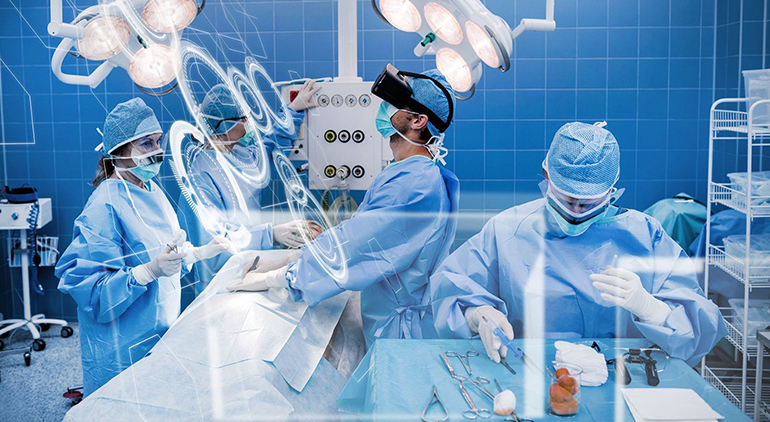As we age, many of us continue to pursue physical activities and recreational sports, but with that comes the inevitable wear and tear on our bodies. For the “weekend warrior,” or individuals who stay active in sports or physical activities despite not being professional athletes, the challenge of maintaining an elevated level of performance while dealing with the aches, pains, and injuries of aging becomes more difficult. Dr. Larry Davidson, a leading expert in minimally invasive spinal surgery, has been a strong advocate for robotic spine surgery as an effective treatment for aging athletes who wish to continue their recreational pursuits, without long recovery times or the risks associated with traditional surgery.
Recreational athletes in their midlife and older years often struggle with back pain, herniated discs, spinal stenosis and other spinal issues. Robotic-assisted surgery offers a minimally invasive solution for these individuals, allowing them to recover quickly, while ensuring that their performance is not compromised. This surgical approach offers the precision needed to address common spinal issues, with the added benefit of a quicker recovery, enabling aging athletes to get back to their activities faster, and with less risk of re-injury.
The Changing Demands of Aging Athletes
As we get older, the demands placed on our bodies during recreational sports change. While younger athletes can often bounce back quickly from injuries, those in midlife and beyond often find that their bodies take longer to heal. For the aging athlete, common injuries such as sprained ligaments, pulled muscles or herniated discs can be more difficult to recover from. These injuries can limit the ability to perform at an elevated level, and as a result, aging athletes may find themselves spending more time on the sidelines.
For athletes experiencing these age-related issues, robotic surgery provides a precise, minimally invasive option for addressing spine-related injuries and conditions. Dr. Larry Davidson highlights that the precision of robotic systems allows for more personalized surgical approaches, which means that the surgery can be tailored to an athlete’s specific needs. The added precision of robotic surgery often results in smaller incisions, reduced muscle disruption and faster recovery times, helping athletes return to their sport more quickly, and with greater confidence.
How Robotic Surgery Benefits Aging Athletes
Robotic-assisted spine surgery offers several benefits, especially for aging athletes. One of the primary advantages is that it is minimally invasive. Traditional spinal surgeries often require large incisions and significant muscle disruption, which can lead to longer recovery periods and increased post-operative pain. Robotic spine surgery, on the other hand, uses smaller incisions and highly accurate surgical instruments, which can lead to less damage to surrounding tissues and a faster healing process.
The ability to recover quickly and return to sport is key for aging athletes. Robotic surgery’s ability to minimize muscle and tissue disruption allows athletes to begin their rehabilitation much sooner than with traditional methods. The faster recovery time also reduces the risk of losing physical conditioning and muscle strength, which can happen with longer recovery periods. It allows athletes to maintain their physical fitness and resume activities, with less downtime and fewer setbacks.
Solutions for Common Spinal Conditions in Aging Athletes
Aging athletes often experience spinal conditions such as degenerative disc disease, herniated discs and spinal stenosis. These conditions can limit the range of motion, cause pain and decrease overall mobility. Robotic spine surgery offers effective solutions for these issues by targeting only the affected areas of the spine, minimizing disruption to surrounding tissues.
For example, with degenerative disc disease, where the discs in the spine begin to wear down, robotic surgery can precisely replace damaged discs or perform a spinal fusion, restoring spinal stability. Similarly, for those suffering from spinal stenosis, where the spinal canal narrows and causes pressure on the nerves, robotic surgery can offer a less invasive approach to decompress the spine, providing pain relief and restoring mobility. These surgeries can significantly improve the quality of life for aging athletes and enable them to return to their sport, with less pain and a reduced risk of future complications.
A Quicker Return to Activity
The ability to return to physical activity as quickly as possible is one of the most important aspects of any treatment. Robotic surgery offers a quicker return to sport than traditional spine surgeries. The smaller incisions and minimally invasive nature of the procedure mean that many patients experience less pain post-surgery, and require less time in the hospital.
In addition, robotic systems’ precision greatly reduces the risk of complications, such as misalignment or nerve damage. For recreational athletes, the ability to resume physical training sooner can be the difference between staying active and being sidelined for an extended period.
Maintaining Peak Performance with Less Downtime
One of the biggest concerns for aging athletes recovering from spine surgery is the preservation of performance. Traditional spine surgery can be invasive and may result in long recovery times, during which athletes lose conditioning and flexibility. Robotic spine surgery may minimize these issues by reducing the time spent recovering, and allowing athletes to begin rehabilitation much sooner.
This faster recovery helps aging athletes return to their peak performance more quickly. With robotic surgery’s precision, the focus is on correcting the problem, while maintaining spinal function and flexibility. Whether an athlete is a runner, tennis player or weekend golfer, robotic spine surgery helps preserve the ability to perform at an elevated level, even as they age.
The Future of Robotic Surgery for Aging Athletes
As robotic technology continues to advance, the benefits for aging athletes will only improve. With the integration of artificial intelligence, enhanced imaging techniques and more sophisticated robotic systems, surgeries are expected to become even more precise and customized to the individual athlete’s needs. These advancements will continue to shorten recovery times, improve outcomes and allow aging athletes to stay active and competitive for much longer.
The future of robotic spine surgery looks promising, with more precise and effective treatments on the horizon. As this technology develops, it will offer even greater benefits to aging athletes, allowing them to recover more quickly and continue their physical activities well into their later years.
Empowering Aging Athletes with Robotic Precision
For aging recreational athletes, staying active and healthy is often a priority, and robotic spine surgery offers a safer and more effective way to achieve that goal. Dr. Larry Davidson emphasizes that as technology advances, these procedures will become even more effective, providing athletes with the opportunity to stay active and recover from injuries faster than ever before.
By embracing robotic surgery, aging athletes can continue to pursue the sports they love, without worrying about prolonged downtime or long-term spinal issues. Robotic surgery offers the precision and personalized care needed to help athletes maintain their physical health, and keep doing what they enjoy for many years to come.


